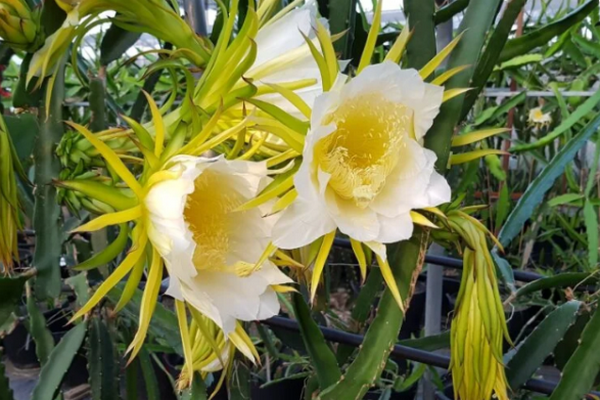The pitaya season is slowly coming to an end in Spain with very positive results, especially for the high-yielding plantations, which have encouraged more and more producers to grow this fruit.

"Years of experience in pitaya cultivation have allowed us, at Pitaya del Sol, to develop a highly efficient cultivation system with which we are helping set up highly profitable plantations, and not only in Spain," says José Ángel Cano. "We are nurseries specialized in pitaya and passion fruit, but we are also growers and, in fact, this season we have marketed 120,000 kilos of pitaya and 40,000 of passion fruit. We want to continue increasing those volumes to be able to export more to Europe, mainly to the Netherlands and the United Kingdom."

"As far as cultivation is concerned, we have managed to increase productivity by using bags with a specific substrate in which the plants develop. You must keep in mind that the root of the pitaya is very thin and has a very low penetration capacity in hard soils, so these hydroponic systems facilitate root development and, therefore, the fruit's production," says Cano.

"Furthermore, this system requires a lot less water. The pitaya plant itself is a cactus, so it needs less water than other plant species, and growing in containers results in very effective irrigation and the substrate not wasting a single drop of the water provided. In addition to optimizing irrigation, this also prevents root diseases and allows the plants to become productive earlier."

José Ángel Cano says that "self-pollinating varieties are also helping maximize the crop's profitability, because they greatly reduce the labor costs of traditional varieties, which have to be pollinated by hand. The initial investment is more expensive, because the cuttings come from Asia and have a higher price, but the crop generates fewer expenses. Another important factor is that the self-pollinating varieties start producing a little earlier and finish a little later."
"With just one hectare using our system, an independent grower can obtain between 40,000 and 60,000 Euro in net revenue"
 Pitaya cultivation is relatively new in Spain, where it has been well accepted and is expanding nicely. "I am from La Mancha and I personally got to know pitaya in Brazil through my wife, who is Brazilian," says José Ángel. "I was not an agricultural producer, but I was fascinated to learn about a fruit that was produced so quickly, that was so good for your health and, moreover, so profitable. So for a while I managed to learn about both pitaya and passion fruit cultivation, visiting producers in Thailand, Brazil and Mexico; learning about different production methods, which varieties were most profitable, etc., and in 2016, we came to Malaga and started Pitaya del Sol."
Pitaya cultivation is relatively new in Spain, where it has been well accepted and is expanding nicely. "I am from La Mancha and I personally got to know pitaya in Brazil through my wife, who is Brazilian," says José Ángel. "I was not an agricultural producer, but I was fascinated to learn about a fruit that was produced so quickly, that was so good for your health and, moreover, so profitable. So for a while I managed to learn about both pitaya and passion fruit cultivation, visiting producers in Thailand, Brazil and Mexico; learning about different production methods, which varieties were most profitable, etc., and in 2016, we came to Malaga and started Pitaya del Sol."
(Photo right: pitaya plantation run by Pitaya del Sol in Latin America).
"We have already set up plantations under this system in Malaga, Cordoba, Seville and other parts of Andalusia, and also along eastern Spain. Thanks to our knowledge on cultivation and continuous research into the production of these two fruits, we have also provided guidance to growers in Ecuador, Mexico and Brazil, where we also have farms with associated growers," he says.

A 7-month old passion fruit plantation in Murcia.
"Pitaya and passion fruit are becoming more and more popular and sales are on the rise. At Pitaya del Sol, we grow without any kind of chemicals and achieve unbeatable results. We have four stores where we sell part of our production, because most of it is intended for export to Europe, and we see that there's a constantly rising demand in European markets and also here in Spain. The fruit is now becoming more and more affordable, but it is still very profitable for the growers; in fact, I always say that these two fruits are ideal for small growers, because they can already make a living with just one hectare," says Cano.

"Given the price paid at source, with efficient plantations and good advice, a hectare of pitaya or passion fruit with 2,000 plants can allow an independent grower to obtain between 40,000 and 60,000 Euro in net revenue," says the producer.

"Our goal is to continue growing in terms of production, both here and in new areas. We are seeing increasingly higher temperatures in the south of Spain. In Cordoba, we have had days with 50 degrees Celsius in the shade, and this is happening more frequently, taking a toll on these crops, despite the fact that pitaya is a cactus. For this reason, we are going to start production trials in partnership with several growers in the north, specifically in La Coruña, where we believe that pitaya could be grown successfully," says José Ángel.
 For more information:
For more information:
Pitaya del Sol
Tel.: +34 662 526 781 / +34 672 674 692
[email protected]
https://pitayadelsol.com










